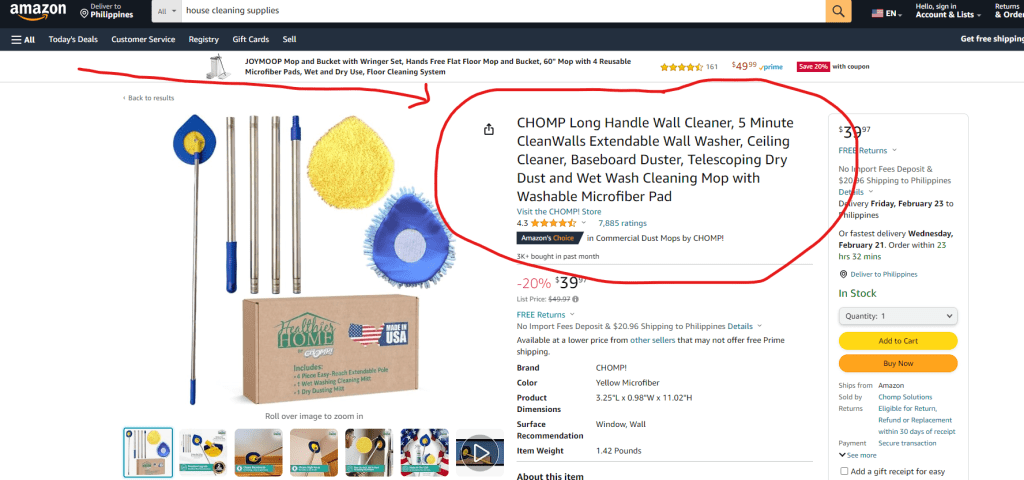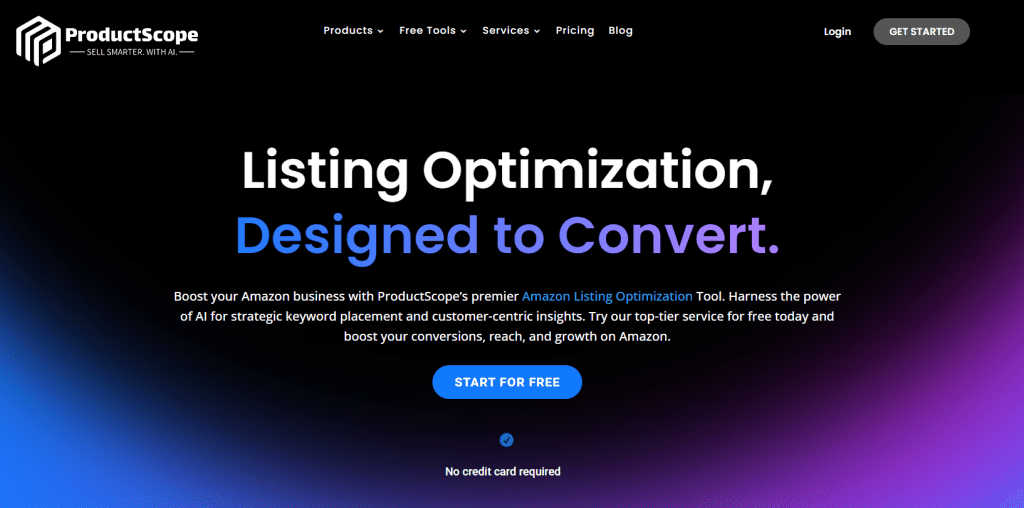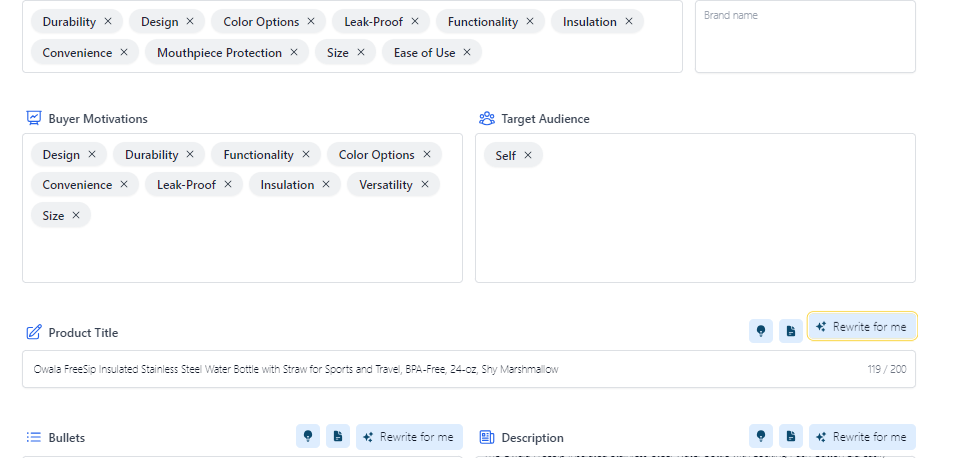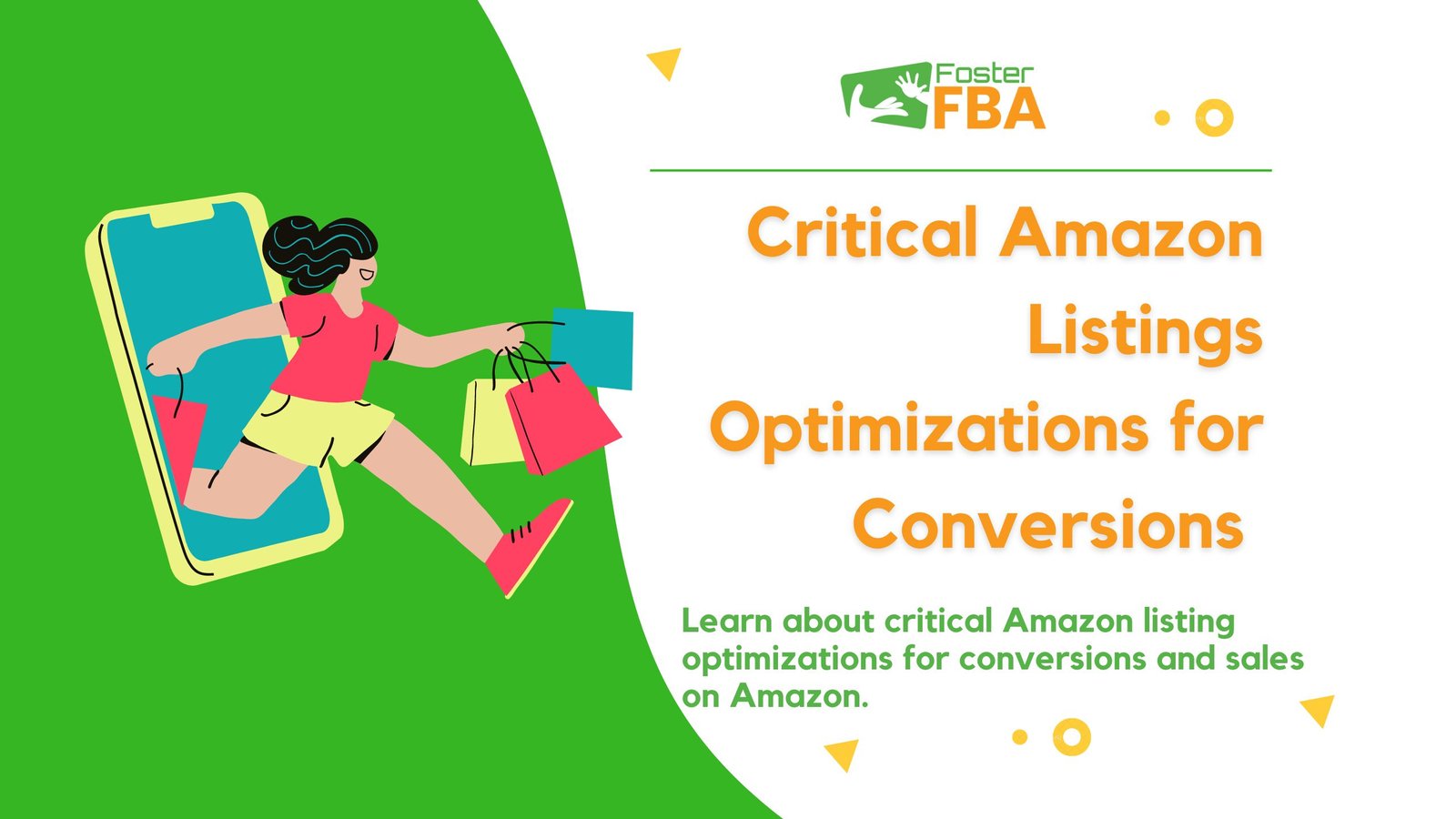Critical Amazon Listings Optimizations is very important because the competition on the Amazon marketplace is intense, and every click has the potential to result in a sale. This becomes especially crucial during major sales events like Amazon Prime Day. Therefore, understanding the difference between Click-Through Rate (CTR) and Conversion Rate Optimization (CVR%) is extremely important. While CTR indicates initial interest, it only provides surface-level information. The real game-changer lies in CVR%, which measures how many clicks lead to purchases.
This shift from simply grabbing attention to securing sales is at the core of successful Amazon listings. By focusing on CVR, sellers can gain a deeper understanding of the effectiveness of their listings, ensuring that interest is captured and converted into tangible sales growth. This, in turn, leads to improved product ranking on Amazon.
As we explore the critical elements of Amazon listing optimizations, remember that the goal is to transform potential interest into confirmed purchases, thereby driving up sales and establishing a more substantial presence in the competitive Amazon marketplace.
Key Takeaways
- Understanding the difference between Click-Through Rate (CTR) and Conversion Rate Optimization (CVR%) is crucial for success on the Amazon marketplace.
- Optimizing product titles through A/B testing and tools like ProductScope AI’s Listing Optimizer can significantly improve visibility and sales.
- Implementing strategic pricing strategies and continuously testing different price points can optimize sales volume and profitability.
- Crafting compelling bullet points that highlight product features and benefits, aligned with customer insights, can enhance buyer interest and improve search visibility.
- Strategic keyword selection for Amazon Ads campaigns, alongside influencer collaborations, can drive targeted traffic and increase sales.
4 Critical Amazon Listings Optimizations
1. The Power of Product Titles

The title of your Amazon product listing plays a pivotal role in capturing the attention of potential buyers and improving your product’s visibility on the platform. It’s the first impression customers have of your product and can significantly influence their decision to click through and learn more. This is where A/B testing, or split testing, becomes invaluable.
A/B testing involves creating two versions of your product title (A and B), each with variations in key descriptive words, their sequence, or the headline’s length and then comparing which version performs better in attracting attention and driving sales. For instance, changing a title from “Eco-Friendly Natural Yoga Mat” to “Sustainable Comfort Yoga Mat” might resonate differently with your target audience. The goal is to determine which title variation captures the shoppers’ interests more effectively.
To execute A/B testing effectively:
- Identify Key Variables: Pinpoint the elements you wish to test in your title. These could include specific keywords, the order of words, or the adherence to the product title character limit.
- Create Two Versions: Develop two titles that only differ in the variables you’ve chosen to test.
- Use a Controlled Environment: Implement these titles in a controlled manner where each version is shown to a similar audience under similar conditions.
- Measure and Compare Results: Analyze click-through rates, conversion rates, and sales data for each title version to determine which performs better.
- Implement Changes: Adopt the title with better performance metrics as your main product title.
Leveraging Tools for Optimization
For brand owners looking to enhance their Amazon search engine marketing efforts without resorting to guesswork, ProductScope AI’s Listing Optimizer is an invaluable tool. It helps generate alternate titles based on customer insights, allowing sellers to tap into a data-driven approach for title optimization. This tool analyzes your existing product titles and customer interaction data to suggest variations that could increase your product’s visibility and appeal. Using ProductScope AI not only helps optimize your titles but also aids in creating winning Amazon product photos that capture buyer attention and improve sales.
In addition to optimizing product titles, high-quality product photos, including techniques like removing background elements, can make your listings stand out and contribute to better click-through rates.

Using ProductScope AI’s Listing Optimizer effectively involves:
- Input Your Current Product Title: Start by providing your current product title to the tool.
- Analyze Customer Insights: The tool uses existing customer data and insights to generate suggestions for title variations that are more likely to resonate with your target audience.
- Generate Alternate Titles: Receive a list of optimized titles based on the analysis.
- Run Split Tests: Implement these alternate titles in Amazon’s Manage Experiments, a Seller Central feature allowing sellers to conduct A/B testing directly on the platform.
- Evaluate Performance: Monitor the performance of each title variation in terms of click-through and conversion rates over a set period, typically a few weeks.
- Implement the Winning Title: Choose the title that demonstrates the best performance in your tests and make it your official product title.
Sellers can significantly enhance their product listings by systematically experimenting with title variations and leveraging optimization tools like ProductScope AI’s Listing Optimizer. This process not only aids in discovering the most effective way to present your product but also ensures that your listings are optimized for both Amazon’s search algorithms and customer preferences, leading to increased visibility and sales. In addition to a listing optimizer, ProductScope AI offers AI tools that can enhance the quality of your images.
2. Pricing Strategies That Work

Getting the best pricing on Amazon requires a nuanced understanding of how different price points can affect customer perception and sales volume. Setting the right price for your product is a delicate balance between ensuring profitability for your business and offering value that customers are willing to pay for. Experimenting with various price points through A/B testing or split-testing is a strategic approach to uncovering the sweet spot that maximizes customer satisfaction and sales revenue.
To explore the subtleties of pricing effectively, consider the following steps:
- Market Research: Understand your competition and the price range for similar products within your category. This gives you a benchmark for setting your prices.
- Customer Segmentation: Identify different customer segments and their price sensitivity. Some segments may prioritize quality over cost, while others are more price-conscious.
- Experiment with Price Points: Implement split-testing by slightly varying the price of your product over a defined period. For example, you could test a kitchen gadget at $29.95 against $32.95 to see which price point leads to better sales volume without deterring customers.
- Monitor Sales and Feedback: Carefully monitor how each price point affects your sales volume, customer feedback, and reviews. This data is invaluable for understanding how price changes impact customer buying behavior.
The Importance of Continuous Testing
In Amazon’s ever-evolving marketplace, where competition is fierce and consumer preferences can shift rapidly, the importance of continuous testing in your pricing strategy cannot be overstated. Adjusting your pricing strategy based on market trends, seasonal demand fluctuations, and competitive dynamics is crucial for maintaining a competitive edge.
Continuous testing involves:
- Regularly Reviewing Your Pricing: Set a schedule to review and adjust your pricing based on performance data, market changes, and competitor pricing strategies.
- Leveraging Amazon’s Tools: Utilize Amazon’s pricing tools and analytics to gain insights into how your pricing strategy compares to the marketplace and identify opportunities for optimization.
- Responding to Market Changes: Be agile in your pricing strategy, ready to adjust prices in response to sales events, holidays, or changes in supply and demand.
- Testing Promotions and Discounts: Experiment with limited-time promotions, discounts, or bundled offers to understand how these strategies can complement your overall pricing strategy and boost sales.
By embracing the subtleties of pricing and the necessity of continuous testing, Amazon sellers can develop a dynamic pricing strategy that aligns with customer expectations, maximizes sales volume, and ensures the long-term success of their business on the platform. This approach helps find the optimal price point that customers are willing to pay and navigate Amazon’s competitive landscape with more agility and strategic insight.
3. Bullet Points That Capture Attention
Bullet points on your Amazon product listing are more than just a list; they are a powerful tool for communicating your product’s unique value proposition to potential buyers. Pairing your product descriptions with creative image ideas that resonate with customer preferences can enhance the visual appeal and encourage conversions. These bullet points should convey what your product does, how it solves a problem, or how it enhances the customer’s life or experience.

Effective bullet points follow a structure that blends technical details with emotional appeal. Start by listing the most important and appealing features of your product. Each bullet point should focus on a single benefit or feature, ensuring clarity and ease of reading. Use persuasive language that speaks directly to the buyer’s needs, desires, or pain points.
For example, instead of stating “made of high-quality material,” explain how this material contributes to the product’s durability and the customer’s long-term satisfaction.
Utilizing Customer Insights
- To ensure your bullet points resonate with your target audience, it’s crucial to understand their preferences, concerns, and the language they use. Utilizing a customer insights Chrome extension can be an invaluable strategy for gathering this intelligence directly from customer reviews and feedback. These tools can help you analyze reviews for common themes, words, and phrases that reflect what features or benefits customers value most about products like yours.
- After gathering these insights, you can refine your bullet points to align with customer interests and language. This alignment makes your listing more relevant and appealing to potential buyers and improves your product’s search visibility on Amazon. Incorporating keywords and phrases from customer reviews can enhance your SEO efforts, making your product easier to find for shoppers using similar language in their searches.
- Finally, integrating these refined bullet points into your listing with the help of tools like ProductScope AI’s Listing Optimizer can streamline the optimization process. This tool can take the insights you’ve gathered and help you craft compelling bullet points optimized for Amazon’s search algorithm. Combining customer-driven content and strategic keyword placement can significantly increase the effectiveness of your bullet points, turning browsers into buyers.
4. Optimizing Keywords for Amazon Ads

The foundation of any successful Amazon advertising campaign lies in the strategic selection of keywords. This meticulous process involves identifying and testing various keywords to discover those that drive the most traffic to your product listings and lead to the highest sales. Alongside keyword optimization, leveraging influencer marketing can further amplify your product’s visibility and attract highly engaged traffic.
Influencers in your product niche can create authentic content that showcases your products, incorporating targeted keywords in their social media posts, blogs, or videos. This synergy enhances your ad spend’s return on investment (ROI) by combining the precision of keyword targeting with the trust and reach of influencer collaborations.
- Start with Comprehensive Keyword Research: Utilize Amazon-focused tools like Helium 10 or Jungle Scout to create an extensive list of potential keywords, including those that could be relevant to influencer marketing content. This foundational step is crucial for setting up effective Amazon Ads campaigns.
- Incorporate a Mix of Keyword Types: Ensure your list includes both short-tail and long-tail keywords. Short-tail keywords are broader and often face more competition, while long-tail keywords are more specific and can lead to higher conversion rates due to their targeted appeal to search queries.
- Implement Keywords into Amazon Ads Campaigns: Take the list of keywords you’ve compiled and integrate them into your Amazon Ads. This should be done methodically to track the performance of each keyword effectively.
- Create Separate Campaigns or Ad Groups: Organize your keywords into different sets or groups, each within its own campaign or ad group. This segmentation allows for more precise monitoring and optimization.
- Monitor Key Performance Metrics: Keep a close eye on important metrics such as click-through rate (CTR), conversion rate (CVR), and overall sales. These indicators will help you gauge the effectiveness of each keyword in your campaigns.
- Evaluate and Refine Your Keyword Strategy: As you gather performance data over time, start to pinpoint which keywords are driving the most traffic and sales. This insight is vital for optimizing your campaigns and ensuring your advertising budget is being used as efficiently as possible.
- Adjust Campaigns Based on Performance: Use the insights gained from your monitoring to refine your keyword strategy. Prioritize high-performing keywords, and consider reallocating your budget to maximize their impact.
Leveraging Expertise for Ad Optimization
While the keyword selection process can be undertaken independently, leveraging expertise in the field can significantly accelerate and enhance your ad optimization efforts. A free PPC (Pay-Per-Click) audit from an experienced Amazon advertising agency, such as FosterFBA, offers a valuable opportunity to uncover hidden opportunities for ad optimization and scalable profit growth.
These audits provide an expert analysis of your current PPC campaigns, identifying strengths, weaknesses, and areas for improvement. An agency like FosterFBA, managing over $100M+ in client revenue annually, has the expertise and data insights to recommend strategic adjustments to improve ad performance. They can help identify underperforming keywords, suggest adjustments to bid strategies, and provide insights into advanced targeting options you may not have considered.
Obtaining a free PPC audit involves contacting the agency with details about your current Amazon Ads campaigns and goals. The audit covers keyword efficiency, ad spend waste, bid strategy effectiveness, and overall campaign structure. By acting on the recommendations provided in the audit, you can optimize your ad campaigns to target high-conversion keywords more effectively, reduce wasted ad spend, and ultimately achieve greater sales and ROI from your Amazon advertising efforts.
Implementing Amazon Conversion Rate Optimization
To truly excel in the competitive Amazon marketplace, implementing targeted Amazon conversion rate optimization strategies is essential. This involves meticulously analyzing and enhancing each aspect of your listings to improve how effectively clicks convert into customer purchases, thereby boosting your overall sales performance.
Cross-Promoting Products on Amazon for Increased Sales

Effective strategies are crucial for maximizing sales and gaining a competitive edge. One powerful method is cross-promotion, which involves marketing complementary products together to boost overall sales. This approach can enhance the shopping experience, increase average order value, and improve customer satisfaction. Here, we delve into the concept of cross-promotion, how to identify suitable products, and strategies to implement it effectively.
The Concept of Cross-Promotion
Cross-promotion is a marketing tactic where related products are promoted together to encourage customers to purchase multiple items. On Amazon, this can be executed through various means, such as product bundling, frequently bought together suggestions, and product recommendations. Cross-promotion leverages the synergy between complementary products to drive additional sales.
For instance, a customer purchasing a camera might also be interested in buying accessories like lenses, memory cards, or tripods. By highlighting these related products, sellers can increase the likelihood of additional purchases. This strategy not only boosts sales but also enhances the customer experience by making it easier to find complementary products.
Identifying Products for Cross-Promotion
Selecting the right products for cross-promotion is crucial for its success. Here are some steps to identify suitable products:
- Analyze Customer Purchase Behavior: Use tools like Amazon’s Brand Analytics to examine customer purchase patterns. Identify which products are frequently bought together and analyze the data to understand customer preferences.
- Evaluate Product Compatibility: Ensure the products you choose to cross-promote are logically related. For example, pairing a smartphone with a protective case or a laptop with a carrying bag makes sense. Unrelated products can confuse customers and dilute the effectiveness of the promotion.
- Customer Feedback and Reviews: Analyze customer reviews and feedback to understand which products are valued together. Positive feedback on bundled products can be a strong indicator of successful cross-promotion opportunities.
Effective Cross-Promotion Strategies
Implementing cross-promotion effectively requires a strategic approach. Here are some proven strategies:
- Product Bundling: Create bundles of related products and offer them at a discounted price. This strategy not only encourages customers to purchase more items but also gives them a sense of value. For example, a skincare brand might bundle a cleanser, toner, and moisturizer together at a reduced price.
- Frequently Bought Together: Utilize Amazon’s “Frequently Bought Together” feature to highlight complementary products. This automated suggestion is based on actual customer purchasing behavior and can significantly boost cross-sales. Studies show that 35% of Amazon’s revenue is generated by its recommendation engine .
- Sponsored Product Ads: Use Sponsored Product Ads to promote complementary products. When a customer views or purchases a product, ads for related items can appear, encouraging additional purchases. This targeted approach ensures that customers see relevant products they are likely to be interested in.
Cross-promotion is a powerful strategy that can significantly enhance sales and customer satisfaction on Amazon. By understanding the concept, identifying suitable products, and implementing effective strategies, sellers can maximize their potential and thrive in the competitive eCommerce landscape.
Conclusion
Mastering Amazon listing optimizations is a dynamic and ongoing process that demands attention to detail, creativity, and strategic thinking. By focusing on key aspects such as product titles, pricing strategies, bullet points, and keyword optimization for Amazon Ads, sellers can significantly enhance their product’s visibility, attract more buyers, and ultimately drive higher sales. The journey from experimentation with title variations and pricing points to the meticulous crafting of bullet points and the strategic selection of keywords requires patience and continuous refinement.
Leveraging tools like ProductScope AI’s Listing Optimizer and seeking expertise through services like FosterFBA’s free PPC audit can provide invaluable insights and support in navigating this complex landscape. As the digital marketplace continues to evolve, the ability to adapt and optimize your listings will remain a critical factor in achieving long-term success on Amazon. Embrace the challenge, harness the tools and expertise available, and watch your efforts translate into tangible results.
Let me know if you have any questions about your Ads Strategy. Happy to do a free audit & strategy session of your entire Ad strategy.
Cheers,

Vijay Jacob
Founder, FosterFBA
Helping 7-8 Figure Amazon Sellers grow profitably with their Amazon Advertising
P.S: If you are making over $10K/month and want to take your PPC sales to the next level. We’re offering “done-for-you” Amazon PPC management & consulting services that does just that. You can schedule a free strategy session and audit of your ads to see if we’re a good fit:

